2) Laboratory for Marine Geology, Qingdao National Laboratory for Marine Science and Technology, Qingdao 266237, China
Submarine soil liquefaction is a common phenomenon of geological disasters. The loss of the soil bearing capacity after liquefaction will have a significant impact on submarine pipelines, submarine cables, and offshore platforms. Pore water pressure, abbreviated as pore pressure, plays an important role in the dynamic response and liquefaction process of the external load in submarine soil (Sumer and Fredsøe, 2002; Jia et al., 2020). The cyclic loading of waves produces excess pore water pressure in the seabed, and its amplitude is the main controlling factor affecting seabed liquefaction (Liu et al., 2006). Research on the dynamic response and liquefaction of the seabed under wave action began in the 1940s. Early studies were conducted using sand soil as the research object. Theoretical studies of waveseabed interactions led to the construction of the constitutive model (Putman, 1949; Sleath, 1970; Yamamoto et al., 1978). The properties of silt, such as clay content and permeability, lie somewhere between sand and clay. Disintegration may occur upon silt-water interaction, except for the cases with sufficient viscosity. Thus, considering silt as
an elastic or viscous medium is impossible. The mechanism of wave-induced silty seabed failure and pore pressure response is complicated (Li et al., 2012) and not well understood.
With the development of high-precision laboratory simulation tests, the stress-strain relationships, pore pressure accumulation, and dissipation processes of submarine soil have been extensively studied by simulating wave action on the seafloor. Common laboratory simulation test methods include the dynamic three-axis test (Wu and Sun, 2013), dynamic-loading ring shear test (Sassa et al., 2012), tank model test (Sumer and Cheng, 2006), centrifugal modeling test (Chen, 2013), and shaking table test (Zhang et al., 2016). The laboratory simulation tests are the most common research methods. However, the size effect and experimental boundary conditions cannot simulate the real conditions in situ, which limits the interaction of the simulated wave and the seabed soil.
In situ data obtained from field monitoring of the pore pressure of submarine soil under wave action can accurately reflect the influence of wave action on the internal stress of soil and deduce the mechanism of the liquefaction process. Therefore, obtaining the pore pressure data in real time is crucial. However, field monitoring of the pore pressure of submarine soil is progressing slowly because of the high research cost and technical difficulty associated with this type of research. Few studies exist on the monitoring of pore pressure and the liquefaction process in a silt seabed during storms (Bennett, 1977; Okusa and Uchida, 1980; Liu et al., 2006; Wang et al., 2017). In situ pore pressure monitoring of a silt seabed under the action of strong wind and waves was conducted in the current study. The obtained data were further analyzed for the pore pressure variation characteristics and process of the silt under the action of the strong wind and waves. The results will provide a basis for subsequent liquefaction research.
2 Monitoring EquipmentThe pore pressure monitoring equipment was self-developed. The core part is a pore pressure monitoring probe (Fig.1a). The pore pressure monitoring probe is a 4.2 m long segmented multisection structure with four pore water pressure sensors. Sensor numbers 1–4 correspond to depths of 0.5, 1.5, 2.5, and 3.5 m, respectively. The probe is inserted into the seafloor using a penetration device (Fig.1b). After the probe is inserted to a predetermined depth, the penetration device is brought back on board, and the probe is set to acquire and store data automatically. Three minutes of data are automatically recorded every 30 min with a frequency of 0.5 Hz during the monitoring period. The pore pressure monitoring probe was deployed in February 2015. Wave, tidal, and current data were collected during the monitoring period.
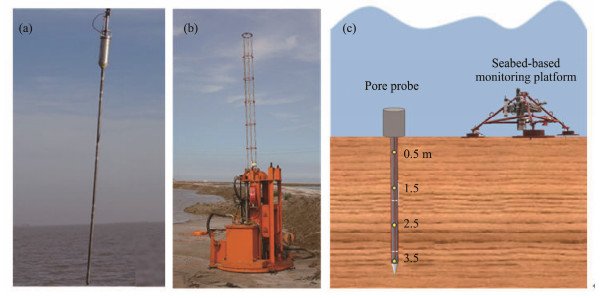
|
Fig. 1 Pore pressure monitoring equipment: (a), pore monitoring probe; (b), penetration equipment; and (c), emplacement sketch of the monitoring instruments, including pore probe and seabed-based monitoring platform (carrying hydrodynamic sensors). |
Silt is widely distributed in the Yellow River Delta and is prone to liquefaction under wave action, which affects the stability of established facilities on it. The Chengdao Oilfield (a major offshore oil and gas development in the Shengli Oilfield) was selected as the study area. This oilfield was formed by flow from the Yellow River through Shenxiangou and Diaokou Basins. The aforementioned flow is characterized by a shallow layer of silt with a short consolidation time. Monitoring seafloor silt pore pressure under wave action in this area will have strong theoretical significance and application value. The position of the monitoring station and a 200 m × 200 m topographic map of the study area are shown in Fig.2.
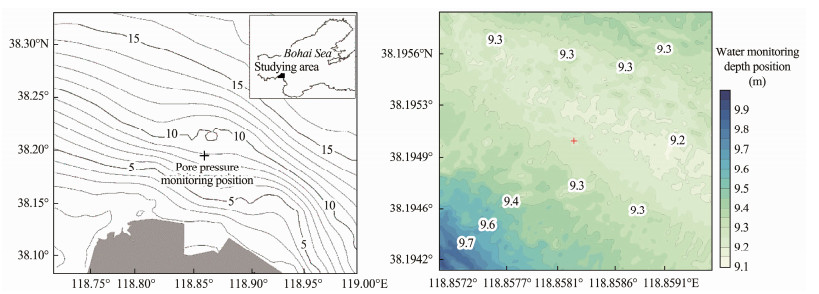
|
Fig. 2 Position and topographic map of the monitoring site. |
Before the monitoring probe was deployed, a bathymetric survey, shallow profile survey, and geological drilling were conducted at the monitoring position. The monitoring position topography is flat with a mean water depth of 9.5 m, which is suitable for the deployment and recovery of the monitoring equipment. The soil layer structure of the monitoring site is undisturbed with high homogeneity. A 4.5 m thick disturbed area is adjacent to the monitoring site (Fig.3a). The cone resistance results show a high-strength layer at a depth of 0.7–2 m (Fig.3b). The surface soil is a typical silt deposit with a thickness of 5.0 m based on a core sample at the site. The geotechnical characteristics of the surface silt are shown in Table 1.
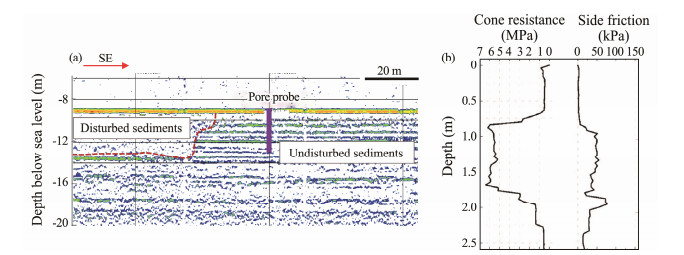
|
Fig. 3 Sub-bottom profile and cone penetration test results from the observation site. |
|
|
Table 1 Characteristics of silt at monitoring positions within a depth of 5 m |
One typical high wave process is chosen as the study period (March 8th at 14:00 to March 10th at 10:30); during this period, the pore water pressure variation characteristics were comprehensively analyzed. The duration of the high wave processes was over 30 h. The significant wave height was up to 2.2 m. The pore pressure, wave height, and tidal level time history curves are shown in Fig.4. Data collected at three-minute intervals were used to draw a continuous curve to observe the overall variation trend of the pore pressure.
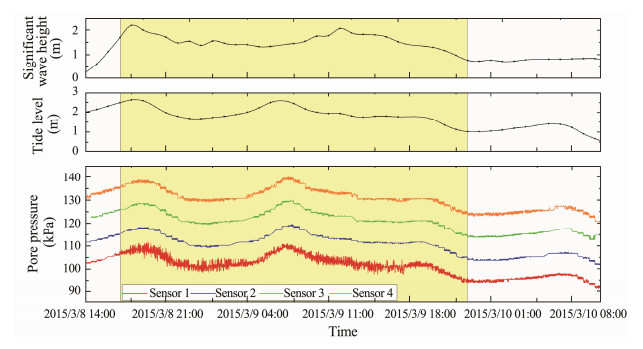
|
Fig. 4 Time history curve of wave height, tide level, and pore pressure. |
The variation trend of the pore pressure measured by the four sensors was remarkably similar, differing by only approximately 10 kPa. When the hydrodynamic effect changed the pore pressure of the seabed soil, the No.1 sensor responded first, followed by sensor Nos.2–4. This pattern was determined by the permeability of the soil. The curve shows a period of oscillating pore pressure with a high amplitude (March 8th at 17:30 to March 9th at 21:00) corresponding to the high wave period (Fig.4).
The variation trend of the pore pressure is consistent with that of the tidal level, which indicates that tide level variations may be the dominant factor causing increasing and decreasing trends of the pore pressure. Pore pressure generally responds to waves and tide. Pore pressure includes hydrostatic and excess pore water pressure. However, only the excess pore water pressure plays a role in soil liquefaction. Changes in tidal level are relatively slow and stable, which is unlikely to induce the formation of excess pore water pressure. Moreover, these changes only endow the hydrostatic pressure with a corresponding response, as shown in the curve trend in Fig.4. Compared with changes in the tidal level, the period of waves is short. Therefore, the cyclic loading of waves will lead to a high amplitude oscillation in pore pressure and the formation of excess pore water pressure in the soil.
The pore pressure changes due to tidal levels were eliminated to study pore pressure in the silt under wave action. Fig.5 shows that the overall trend of wave-induced pore pressure responses was flat.
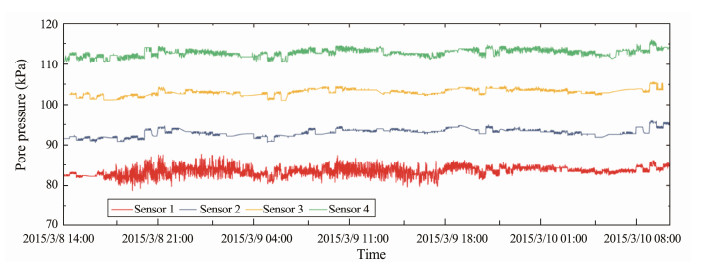
|
Fig. 5 Wave-induced change in pore pressure. |
Figs.4 and 5 show that the pore pressure measured by the No.1 sensor was strongly affected by wave action. The amplitude of the pore pressure trend drastically increased during the period of high wave height, indicating that pore pressure had a significant response to wave action. The pore pressure response gradually weakened when the wave height decreased. However, the influence of waves on pore pressure at depths larger than 1.5 m was insignificant. Notably, the wave height was initially substantially small (Fig.4), which cannot possibly induce a pore pressure response. Meanwhile, the data of each sensor demonstrated a certain degree of oscillation, which should be regarded as sensor background values. Therefore, the depth of the silt that can be significantly affected under wave action (1.5–2 m significant wave height) is approximately 0.5–1.5 m. An occasional slight fluctuation at depths larger than 1.5 m is also observed.
5 Discussion 5.1 Lag Effect of Pore Pressure ResponseThe oscillation response of pore pressure is dominated by the cyclic action of wave crests and troughs. In situ observational data revealed a significant lag effect in the pore pressure response during the high wave period. The oscillation response of the pore pressure did not immediately appear as the wave height increased under an approaching storm. Similarly, when the wind and waves were reduced, the pore water pressure oscillation amplitude did not decrease immediately but continued to oscillate for a period.
During the high wave period in March, periods of increasing and decreasing wave height were chosen to analyze the evolution of pore pressure response to wave actions (Fig.6). The results showed that the pore pressure did not increase or oscillate rapidly when the wave height increased rapidly. Instead, the pore pressure remained relatively stable for a period before the intense oscillation began (Fig.7). When the significant wave height was larger than 2 m at the beginning of the oscillation response, the oscillation was in a high-amplitude status throughout the entire high wave process, even though the wave height was lower than that at the startup of the pore pressure response. As the storm neared its end, the wave height decreased rapidly while the pore pressure oscillation response was maintained until the wave height was lower than 0.8 m (Fig.7).
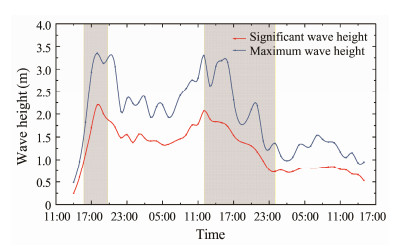
|
Fig. 6 Periods of wave height increase and decrease (March 8th to 9th). |
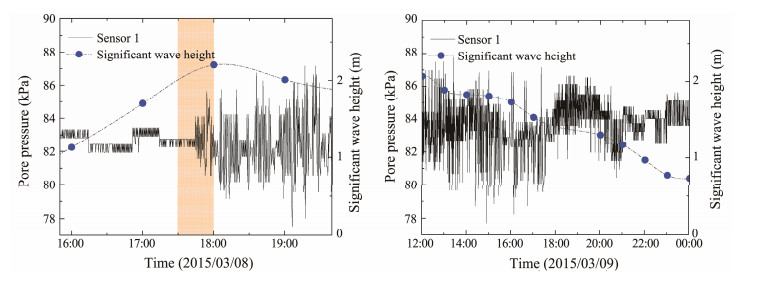
|
Fig. 7 Change process of pore pressure with the increase and decrease of wave height. |
Different from the pore pressure phase-lag effect, which is a conspicuous phase lag in the pressure that emerges as depth increases (Wang et al., 2014), the lag effect highlighted in this study indicates that the transient pore pressure in the seabed does not respond immediately to the wave-induced pressure stress on the seabed surface possibly due to the change in soil permeability. The collected data during the 17:30–18:00 period (Fig.7) show the sudden initiation of significant transient pore pressure response at the 0.5 m depth. The pore pressure response before the initiation was weak, even negligible, and without pore pressure accumulation. The in situ observation data revealed a significant difference between the wave heights associated with the initiation and end periods of the pore pressure response. This finding indicated that the permeability of sediment above 0.5 m depth changed under wave action, increasing the sensitivity of the pore pressure dynamic response. Therefore, the pore pressure oscillation could be significant under wavelet action near the end of the storm. The in situ observation and wave flume test results of Wang et al. (2020) demonstrated that the failure zone gradually expanded under wave action after the initiation of sediment failure. The failed sediments underwent oscillating motion governed by wave actions. The large shear strain facilitated the rearrangement of sediment grains and the increase in pore volume during this process. Consequently, the porosity and permeability of the sediments increased. The in situ pore pressure data in this study support the conclusion of Wang et al. (2020). The mechanism of the transient pore pressure response lag effect is also explained by this theory.
5.2 Characteristics of Excess Pore Pressure ResponseTwo phenomena, including the transient and cumulative responses of the soil under the action of waves, have been found through field monitoring and indoor simulation experiments (Nago et al., 1993; Jeng and Seymour, 2007; Jeng, 2012). The transient response is also called the oscillating response. This response is the real-time pulsation of the pore water pressure in the soil to the wave action, which is often accompanied by amplitude attenuation and phase retardation of the pore pressure (Yamamoto et al., 1978; Jeng, 1997). The cumulative response is the residual pore pressure increasing or decreasing effect of submarine soil under the wave circulation action. This phenomenon is caused by the compression deformation of soil skeletons and is similar to the soil liquefaction caused by earthquakes (Seed and Rahman, 1978; Sumer et al., 1999). In contrast to residual liquefaction, instantaneous liquefaction (also called 'momentary liquefaction') is induced by upward seepage in the upper layer of the seabed under wave troughs. Similar to the quicksand phenomenon, the instantaneous liquefaction may particularly occur in a sandy or nonplastic silty seabed. The buoyant weight of the soil is balanced by the seepage force, and the confining stress vanishes during instantaneous liquefaction (Qi and Gao, 2018).
The excess pore pressures at each depth were obtained in the current study by subtracting the overlying static pore pressure from the total pore pressure. Notably, the excess pore pressure shown in Fig.8 can only reflect the accumulation or dissipation trend of the excess pore pressure due to the lack of dynamic water pressure parameters on the seabed surface. The oscillation amplitude cannot quantitatively describe the transient or accumulation of the excess pore pressure inside the seabed. The sensor data at four depths reveal that only sensor No.1 had a dynamic response, which is a transient oscillation response accompanied by a slight accumulation and dissipation of pore pressure. Sensor No.2 had only a slight accumulation and dissipation of pore pressure, with almost no oscillation response. Excess pore pressure does not typically accumulate under weak wave action due to its relatively high dissipation rate. In addition, no significant excess pore pressure gradients compared with those of each depth exist, indicating that the wave actions were insufficiently strong to induce seepage in the deep soil. Thus, these gradients can not produce excess pore pressure oscillation, accumulation, or subsequent soil liquefaction. No wave-induced excess pore pressure in the soil under 0.5 m below the seabed is observed, and the soil deeper than 0.5 m below the seabed could not be easily liquefied.
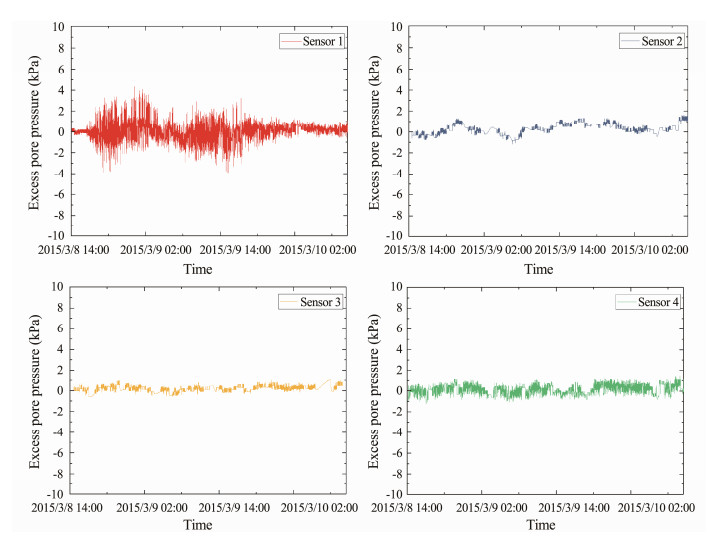
|
Fig. 8 Change in excess pore pressure from each sensor. |
As mentioned above, the permeability of the shallow soil gradually changed under cyclic wave loading, leading to a sudden increase in the transient pore pressure amplitude. While no significant pore pressure accumulation was observed, the transient and residual pore pressure responses may not have occurred simultaneously. The transient response of the pore pressure is sensitive to the silt soil, which is highly significant for the pore pressure response and the silt liquefaction process.
5.3 Concept Model of Pore Pressure ResponseWave action will change the stress state inside the soil and then influence the pore pressure in the seabed silt. The stress within the soil due to waves is gradually transferred into the soil particles through the pore water. The cyclic stress induced by the wave will increase the pore pressure in the silt. The pore water pressure will then continue to decrease through pore permeability. Therefore, the variation in pore pressure development depends on the difference between the rate of pore pressure accumulation and dissipation. When the depth of the seabed deepens, the increase in pore pressure caused by waves is weakened and the pore permeability decreases. Meanwhile, the pore pressure no longer responds when the depth of the seabed exceeds the scope of the wave action. Under different soil conditions, a maximum depth of pore pressure response is observed under different conditions of wave action.
The current study summarizes a concept model of silt soil pore pressure response under different wave actions, as shown in Fig.9. Within the scope of the wave action influence depth, an oscillation response with a small amplitude occurs when the wave action intensity is substantially small. The oscillation response persists with increased amplitude as the wave height rises. However, the pore pressure has no cumulative response because its accumulation rate is less than the dissipation rate. Oscillation and cumulative response in the pore pressure emerge when the wave action is sufficiently strong. Soil failure occurs when the cumulative pore pressure reaches the critical value of instability (Wang and Liu, 2016). Notably, the process of pore pressure accumulation has been covered in previous research (Sumer et al., 2006). However, the process of pore pressure oscillation response without an accumulating response is often ignored. This process is of considerable importance for transient liquefaction (Qi and Gao, 2018) and the initiation of the pore pressure response.
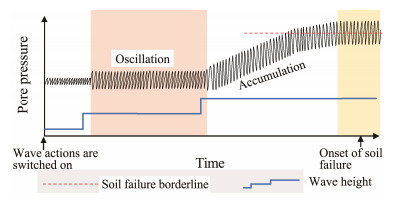
|
Fig. 9 Concept model of pore pressure response under different wave actions (lag effect of pore pressure response is considered in the model). |
Independently developed pore pressure monitoring equipment was used to collect in situ observations of pore pressure responses in the subaqueous Yellow River Delta during a period of strong waves. The in situ observation methods are advanced. Valuable data were accurately recorded at different depths. The complete process of pore pressure response from initiation to the end during a storm was revealed.
The trend of total pore pressure is controlled by changes in tidal level. Wave-induced pore pressure response is mainly an oscillation response without accumulation due to the insufficiently strong wave action. The maximum response depth was approximately 0.5 m with 2 m wave heights. A significant lag effect is observed in the pore pressure response. The transient pore pressure in the seabed does not respond immediately to the wave-induced pressure stress on the seabed surface, which is caused by the change in soil permeability.
A concept model of silt soil pore pressure response under different wave actions was developed. The accumulation rate of pore pressure is less than the dissipation rate, and the oscillation pore pressure response without accumulation is highlighted in the model. The highlighted response process is of considerable importance for transient liquefaction and the initiation of the pore pressure response.
AcknowledgementsThis work was sponsored by the National Special Project for Marine Public Welfare Industry (No. 201005005), the National Natural Science Foundation of China (Nos. 42107207, 41876066), the Natural Science Foundation of Shandong Province (No. ZR2020QD067), and the Postdoctoral Innovation Project of Shandong Province (No. 20 2002042).
Bennett, R. H., 1977. Pore-water pressure measurements: Mississippi Delta submarine sediments. Marine Geotechnology, 2(1): 177-189. (  0) 0) |
Chen, Z. C., 2013. Centrifugal modeling test on wave-induced dynamic response of seabed. Master thesis. Dalian University of Technology.
(  0) 0) |
Jeng, D. S., 1997. Soil response in cross-anisotropic seabed due to standing waves. Journal of Geotechnical and Geoenvironmental Engineering, 123(1): 9-19. DOI:10.1061/(ASCE)1090-0241(1997)123:1(9) (  0) 0) |
Jeng, D. S., 2012. Porous Models for Wave-Seabed Interactions. Shanghai Jiao Tong University Press and Springer-Verlage, Shanghai, 289pp.
(  0) 0) |
Jeng, D. S., and Seymour, B. R., 2007. Simplified analytical approximation for pore-water pressure buildup in marine sediments. Journal of Waterway, Port, Coastal, and Ocean Engineering, 133(4): 309-312. DOI:10.1061/(ASCE)0733-950X(2007)133:4(309) (  0) 0) |
Jia, Y. G., Liu, X. L., Zhang, S. T., Shan, H. X., and Zheng, J. W., 2020. Wave-Forced Sediment Erosion and Resuspension in the Yellow River Delta. Springer Oceanography, Springer, Singapore, 292pp.
(  0) 0) |
Li, A. L., Li, G. X., Lin, L., and Xu, G. H., 2012. Experimental study on pore pressure responses to wave action on silt seabed. Marine Science Bulletin, 31(1): 15-20 (in Chinese with English abstract). DOI:10.3969/j.issn.1001-6392.2012.01.003 (  0) 0) |
Liu, T., Feng, X. L., and Lin, L., 2006. Study of seabed pore water pressure based on in situ test and numerical simulation. Acta Oceanlogica Sinca, 28(3): 173-176 (in Chinese with English abstract). (  0) 0) |
Nago, H., Maeno, S., Matsumoto, T., and Haehiman, Y., 1993. Liquefaction and densification of loose deposited sand bed underwater pressure variation. Proceedings of the Third International Offshore and Polar Engineering. Singapore, 578-584.
(  0) 0) |
Okusa, S., and Uchida, A., 1980. Pore-water pressure change in submarine sediments due to waves. Marine Geotechnology, 4(2): 145-161. DOI:10.1080/10641198009379819 (  0) 0) |
Putman, J. A., 1949. Loss of wave energy due to percolation in a permeable sea bottom. Transactions, American Geophysical Union, 30(3): 349-356. DOI:10.1029/TR030i003p00349 (  0) 0) |
Qi, W. G., and Gao, F. P., 2018. Wave induced instantaneously-liquefied soil depth in a non-cohesive seabed. Ocean Engineering, 153: 412-423. DOI:10.1016/j.oceaneng.2018.01.107 (  0) 0) |
Sassa, K., He, B., Miyagi, T., Strasser, M., Konagai, K., Ostric, M., et al., 2012. A hypothesis of the Senoumi submarine megaslide in Suruga Bay in Japan – based on the undrained dynamic-loading ring shear tests and computer simulation. Landslides, 9: 439-455. DOI:10.1007/s10346-012-0356-2 (  0) 0) |
Seed, H. B., and Rahman, M. S., 1978. Wave-induced pore pressure in relation to ocean floor stability of cohesionless soils. Marine Geotechnology, 3(2): 123-150. DOI:10.1080/10641197809379798 (  0) 0) |
Sleath, J. F. A., 1970. Wave-induced pressures in beds of sand. Journal of the Hydraulics Division, 96(2): 367-378. DOI:10.1061/JYCEAJ.0002325 (  0) 0) |
Sumer, B. M., and Cheng, N. S., 1999. A random-walk model for pore pressure accumulation in marine soils. Proceedings 9th International Offshore and Polar Engineering Conference. Brest, 521-526.
(  0) 0) |
Sumer, B. M., and Fredsøe, J., 2002. The Mechanics of Scour in the Marine Environment. World Scientific Publishing, Singapore, 552pp.
(  0) 0) |
Sumer, B. M., Hatipoglu, F., and Fredsøe, J., 2006. The sequence of sediment behaviour during wave-induced liquefaction. Sedimentology, 53(3): 611-629. (  0) 0) |
Wang, H., and Liu, H. J., 2016. Evaluation of storm wave-induced silty seabed instability and geo-hazards: A case study in the Yellow River Delta. Applied Ocean Research, 58: 135-145. DOI:10.1016/j.apor.2016.03.013 (  0) 0) |
Wang, Y. F., Gao, F. P., and Qi, W. G., 2014. Cyclic pore pressure generation in silty soils under the action of combined waves and current. Geotechnical Engineering Journal of the SEAGS & AGSSEA, 45(4): 40-45. (  0) 0) |
Wang, Z. H., Jia, Y. G., Liu, X. L., Wang, D., Shan, H. X., Guo, L., et al., 2017. In situ observation of storm-wave-induced seabed deformation with a submarine landslide monitoring system. Bulletin of Engineering Geology & the Environment, 77: 1091-1102. (  0) 0) |
Wang, Z. H., Sun, Y. F., Jia, Y. G., Shan, Z. G., Shan, H. X., Zhang, S. T., et al., 2020. Wave-induced seafloor instabilities in the subaqueous Yellow River Delta – initiation and process of sediment failure. Landslides, 17: 1849-1862. DOI:10.1007/s10346-020-01399-2 (  0) 0) |
Wu, B., and Sun, D. A., 2013. Study of liquefaction characteristics of unsaturated silt. Rock and Soil Mechanics, 34(2): 411-416. (  0) 0) |
Yamamoto, T., Koning, H. L., and Sellmejjer, H., 1978. On the response of a poro-elastic bed to water waves. Journal of Fluid Mechanics, 87(1): 193-206. DOI:10.1017/S0022112078003006 (  0) 0) |
Zhang, X. L., Wang, Z. H., and Xu, Z. W., 2016. Shaking table tests on flow effects of liquefied sands. Rock and Soil Mechanics, 37(8): 2347-2352. (  0) 0) |
 2022, Vol. 21
2022, Vol. 21


